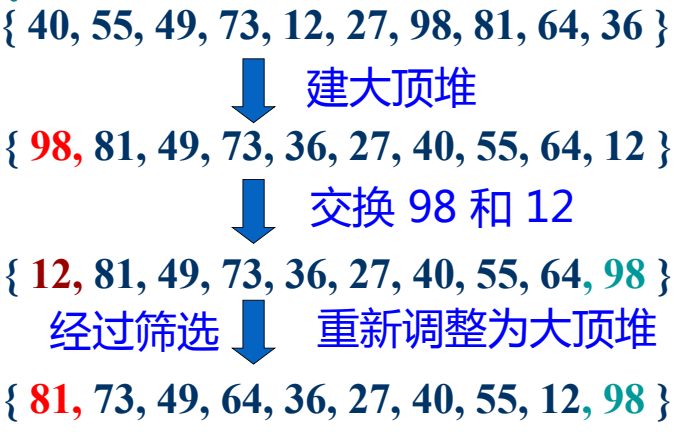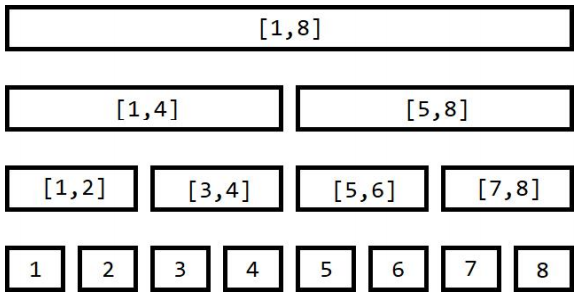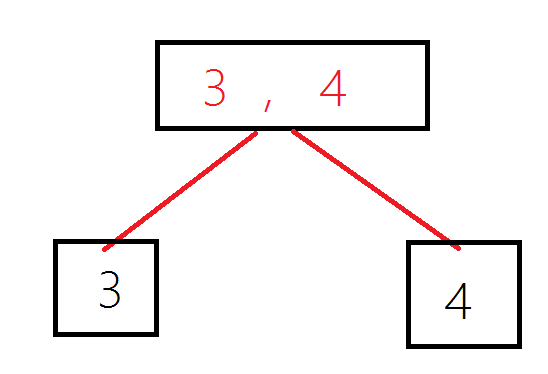主要内容:
1.堆
2.并查集
3.线段树
4.可持久化线段树
5.树状数组
堆
定义:
堆(heaps)不是容器,而是一种特别的数据组织方式。堆一般用来保存序列容器。
1.堆是一棵完全二叉树
2.不仅仅是完全二叉树
种类:
1.大根堆:
每个结点的权值都比儿子的权值大
2.小根堆:
每个结点的权值都比儿子的权值小
3.因为堆的性质,大根堆的根结点一定权值最大,小根堆的根结点一定权值最
小
优先队列:
优先队列定义: priority_queue<Type, Container, Functional>
tips:Type 就是数据类型,Container 就是容器类型(Container必须是用数组实现的容器,比如vector,deque等等,
但不能用 list。STL里面默认用的是vector),Functional 就是比较函数,当需要用自定义的数据类型时才需要
传入这三个参数,使用基本数据类型时,只需要传入数据类型,默认是大顶堆。
priority_queue <int, vector<int>, greater<int> > q; //升序队列
priority_queue <int, vector<int>, less<int> >q; //降序队列
头文件:
#include <queue>
基本操作:
empty() 如果队列为空,则返回真
pop() 删除对头元素,删除第一个元素
push() 加入一个元素
size() 返回优先队列中拥有的元素个数
top() 返回优先队列对头元素,即优先级最高的元素
在默认的优先队列中,优先级高的先出队。在默认的int型中先出队的为较大的数。
结构体创建优先队列:
#include<bits/stdc++.h> #include<queue> using namespace std; const int maxn=10010; struct node { int v; bool operator<(const struct node x)const { return v>x.v; } }cur; priority_queue<struct node> pq; int main() { int n,sum=0; scanf("%d",&n); for(int i=0; i<n; i++) { scanf("%d",&cur.v); pq.push(cur); } for(int i=1; i<n; i++) { cur=pq.top(); pq.pop(); cur.v+=pq.top().v; pq.pop(); sum+=cur.v; pq.push(cur); } printf("%d\n",sum); return 0; }
堆排序:
即利用堆的特性进行排序的一种排序方法。
1. 建立初始大顶堆,即将整个序列调整为堆
2. 输出根结点,将堆顶元素和最后元素交换,从堆中删除原来的堆顶元素
3. 重新调整为大顶堆
4.重复第2、3步,直到所有的元素都被删除。

堆排序模板:
#include<bits/stdc++.h> using namespace std; const int N = 100010; int n, m; int h[N], cnt; void down(int u) { int t = u; if (u * 2 <= cnt && h[u * 2] < h[t]) t = u * 2; if (u * 2 + 1 <= cnt && h[u * 2 + 1] < h[t]) t = u * 2 + 1; if (u != t) { swap(h[u], h[t]); down(t); } } int main() { scanf("%d%d", &n, &m); for (int i = 1; i <= n; i ++ ) scanf("%d", &h[i]); cnt = n; for (int i = n / 2; i; i -- ) down(i); while (m -- ) { printf("%d ", h[1]); h[1] = h[cnt -- ]; down(1); } puts(""); return 0; }
并查集
定义:
并查集是一种多叉树,用于处理一些不相交集合的合并及查询问题。
1.初始化:每个结点单独作为一个集合。
2.查询:求元素所在的集合的代表元素,即根结点。
3.合并:将两个元素所在的集合,合并为一个集合。
例题:
P2024 [NOI2001] 食物链
题目描述
动物王国中有三类动物 A,B,C,这三类动物的食物链构成了有趣的环形。A 吃 B,B 吃 C,C 吃 A。
现有 N 个动物,以 1 - N 编号。每个动物都是 A,B,C 中的一种,但是我们并不知道它到底是哪一种。
有人用两种说法对这 N 个动物所构成的食物链关系进行描述:
- 第一种说法是
1 X Y,表示 X 和 Y 是同类。 - 第二种说法是
2 X Y,表示 X 吃 Y 。
此人对 N 个动物,用上述两种说法,一句接一句地说出 K 句话,这 K 句话有的是真的,有的是假的。当一句话满足下列三条之一时,这句话就是假话,否则就是真话。
- 当前的话与前面的某些真的话冲突,就是假话
- 当前的话中 X 或 Y 比 N 大,就是假话
- 当前的话表示 X 吃 X,就是假话
你的任务是根据给定的 N 和 K 句话,输出假话的总数。
输入格式
第一行两个整数,N,K,表示有 N 个动物,K 句话。
第二行开始每行一句话(按照题目要求,见样例)
输出格式
一行,一个整数,表示假话的总数。
输入输出样例
100 7 1 101 1 2 1 2 2 2 3 2 3 3 1 1 3 2 3 1 1 5 5
3
说明/提示
1 ≤ N ≤ 5 ∗ 10^4
1 ≤ K ≤ 10^5
#include<bits/stdc++.h> using namespace std; const int N=50010; struct node { int pre; int relation; } p[N]; int find(int x) { int temp; if(x == p[x].pre) return x; temp = p[x].pre; p[x].pre = find(temp); p[x].relation = (p[x].relation + p[temp].relation)%3; return p[x].pre; } int main() { int n,k; int ope,a,b; int root1,root2; int sum=0; scanf("%d%d",&n,&k); for(int i=1; i<=n; ++i) { p[i].pre=i; p[i].relation = 0; } for(int i = 1; i <= k; ++i) { scanf("%d%d%d", &ope, &a, &b); if(a>n|| b>n) { sum++; continue; } if(ope == 2 && a == b) { sum++; continue; } root1 = find(a); root2 = find(b); if(root1 != root2) { p[root2].pre = root1; p[root2].relation = (3 + (ope - 1) +p[a].relation - p[b].relation) % 3; } else { if(ope == 1 && p[a].relation != p[b].relation) { sum++; continue; } if(ope == 2 && ((3 + p[b].relation - p[a].relation) % 3 != ope - 1)) { sum++; continue; } } } printf("%d\n", sum); return 0; }#include<bits/stdc++.h> using namespace std; const int N=50010; struct node { int pre; int relation; } p[N]; int find(int x) { int temp; if(x == p[x].pre) return x; temp = p[x].pre; p[x].pre = find(temp); p[x].relation = (p[x].relation + p[temp].relation)%3; return p[x].pre; } int main() { int n,k; int ope,a,b; int root1,root2; int sum=0; scanf("%d%d",&n,&k); for(int i=1; i<=n; ++i) { p[i].pre=i; p[i].relation = 0; } for(int i = 1; i <= k; ++i) { scanf("%d%d%d", &ope, &a, &b); if(a>n|| b>n) { sum++; continue; } if(ope == 2 && a == b) { sum++; continue; } root1 = find(a); root2 = find(b); if(root1 != root2) { p[root2].pre = root1; p[root2].relation = (3 + (ope - 1) +p[a].relation - p[b].relation) % 3; } else { if(ope == 1 && p[a].relation != p[b].relation) { sum++; continue; } if(ope == 2 && ((3 + p[b].relation - p[a].relation) % 3 != ope - 1)) { sum++; continue; } } } printf("%d\n", sum); return 0; }
线段树
定义:
线段树是一种二叉搜索树(实质是平衡二叉树),线段树的每个结点都存
储了一个区间,也可以理解成一个线段。

用途:
1.线段树的适用范围很广,可以维护修改以及查询区间上的最值、
求和。更可以扩充到二维线段树(矩阵树)和三维线段树(空间
树)。对于一维线段树来说,每次更新以及查询的时间复杂度为
O(log n)。
2.事实上,线段树多用于解决区间问题,但并不是线段树只能解决
区间问题。
看来前面以后,可能觉得线段树也没有那么难,很好理解。
确实,线段树概念很好理解,但有可能像本蒟蒻一样……
老师:“会了吗?”
我:“会!”。
老师:“真会了?”
我:“真会了!——吧”。
“线段树的思路和理解都木得问题,但这写代码就有些困难了”.
接下来就带大家写一下代码。。。。。。。
递归建树:
void build(int l,int r,int x) { if(l == r) tree[x].sum = a[l]; else { int mid = l + ((r-l)>>1); build(l,mid, x<<1); build(mid+1,r, x<<1|1); pushup(x); } }
单点修改:
#define lc x<<1 #define rc x<<1|1 #define mid ((l+r)>>1) void pushup(int x) { tree[x].sum=tree[lc].sum+tree[rc].sum; } void update(int x,int l,int r,int p,int v) { if(l==r) { tree[x].sum=v; return; } if(p<=mid)update(lc,l,mid,p,v); else update(rc,mid+1,r,p,v); pushup(x); }
区间查询求和:
int query(int x,int l,int r,int from,int to) { if(l>=from && r<=to)return tree[x].sum; int ans=0; if(from<=mid)ans+=query(lc,l,mid,from,to); if(to>mid)ans+=query(rc,mid+1,r,from,to); return ans; }
这里的pushup(x)是什么呢?
其实这就类似于爆搜中的回溯,但不是还原现场,
……
难说,举个栗子

在上面,我们给区间下了一个懒标记,这个语句呢,
就相当于是将3,4这个区间往下一层,变成区间3和区间4.
下面看一下完整模板:
P3372 【模板】线段树 1
题目描述
如题,已知一个数列,你需要进行下面两种操作:
- 将某区间每一个数加上 kk。
- 求出某区间每一个数的和。
输入格式
第一行包含两个整数 n, mn,m,分别表示该数列数字的个数和操作的总个数。
第二行包含 nn 个用空格分隔的整数,其中第 ii 个数字表示数列第 ii 项的初始值。
接下来 mm 行每行包含 33 或 44 个整数,表示一个操作,具体如下:
1 x y k:将区间 [x, y][x,y] 内每个数加上 kk。2 x y:输出区间 [x, y][x,y] 内每个数的和。
输出格式
输出包含若干行整数,即为所有操作 2 的结果。
输入输出样例
5 5 1 5 4 2 3 2 2 4 1 2 3 2 2 3 4 1 1 5 1 2 1 4
11 8 20
说明/提示
对于 30\%30% 的数据:n \le 8n≤8,m \le 10m≤10。
对于 70\%70% 的数据:n \le {10}^3n≤103,m \le {10}^4m≤104。
对于 100\%100% 的数据:1 \le n, m \le {10}^51≤n,m≤105。
保证任意时刻数列中任意元素的和在 [-2^{63}, 2^{63})[−263,263) 内。
【样例解释】

#include<bits/stdc++.h> #define LL long long using namespace std; struct cs { LL ll,rr,vv; } T[824290]; LL a[200005],v[824290]; LL n,m,x,y,z,sum,N; void clean(LL x) { if(!v[x])return; T[x].vv+=(T[x].rr-T[x].ll+1)*v[x]; if(T[x].ll!=T[x].rr) { v[x*2]+=v[x]; v[x*2+1]+=v[x]; } v[x]=0; } void maketree(LL x,LL y,LL num) { T[num].ll=x; T[num].rr=y; if(x==y) { T[num].vv=a[x]; return; } maketree(x,(x+y)/2,num*2); maketree((x+y)/2+1,y,num*2+1); T[num].vv=T[num*2].vv+T[num*2+1].vv; } void inc(LL x,LL y,LL z,LL num) { clean(num); if(x<=T[num].ll&&T[num].rr<=y) { v[num]+=z; return; } T[num].vv+=(min(y,T[num].rr)-max(x,T[num].ll)+1)*z; if(T[num].ll==T[num].rr) return; int mid=(T[num].ll+T[num].rr)/2; if(x>mid)inc(x,y,z,num*2+1); else if(y<=mid)inc(x,y,z,num*2); else { inc(x,y,z,num*2); inc(x,y,z,num*2+1); } } void out(int LL,int LL,LL num) { clean(num); if(x<=T[num].ll&&T[num].rr<=y) { sum+=T[num].vv; return; } int mid=(T[num].ll+T[num].rr)/2; if(x>mid)out(x,y,num*2+1); else if(y<=mid)out(x,y,num*2); else { out(x,y,num*2); out(x,y,num*2+1); } } int main() { scanf("%d%d",&n,&N); for(int i=1; i<=n; i++)scanf("%d",&a[i]); maketree(1,n,1); for(int i=1; i<=N; i++) { scanf("%d%d%d",&m,&x,&y); if(m==1) { scanf("%d",&z); inc(x,y,z,1); } else { sum=0; out(x,y,1); printf("%lld\n",sum); } } return 0; }
线段树的代码普遍都很长,不像DP,所以线段树的区间删除、
区间求和、改变区间……都需要我们“背”;






【推荐】国内首个AI IDE,深度理解中文开发场景,立即下载体验Trae
【推荐】编程新体验,更懂你的AI,立即体验豆包MarsCode编程助手
【推荐】抖音旗下AI助手豆包,你的智能百科全书,全免费不限次数
【推荐】轻量又高性能的 SSH 工具 IShell:AI 加持,快人一步
· 分享一个免费、快速、无限量使用的满血 DeepSeek R1 模型,支持深度思考和联网搜索!
· 基于 Docker 搭建 FRP 内网穿透开源项目(很简单哒)
· ollama系列01:轻松3步本地部署deepseek,普通电脑可用
· 25岁的心里话
· 按钮权限的设计及实现